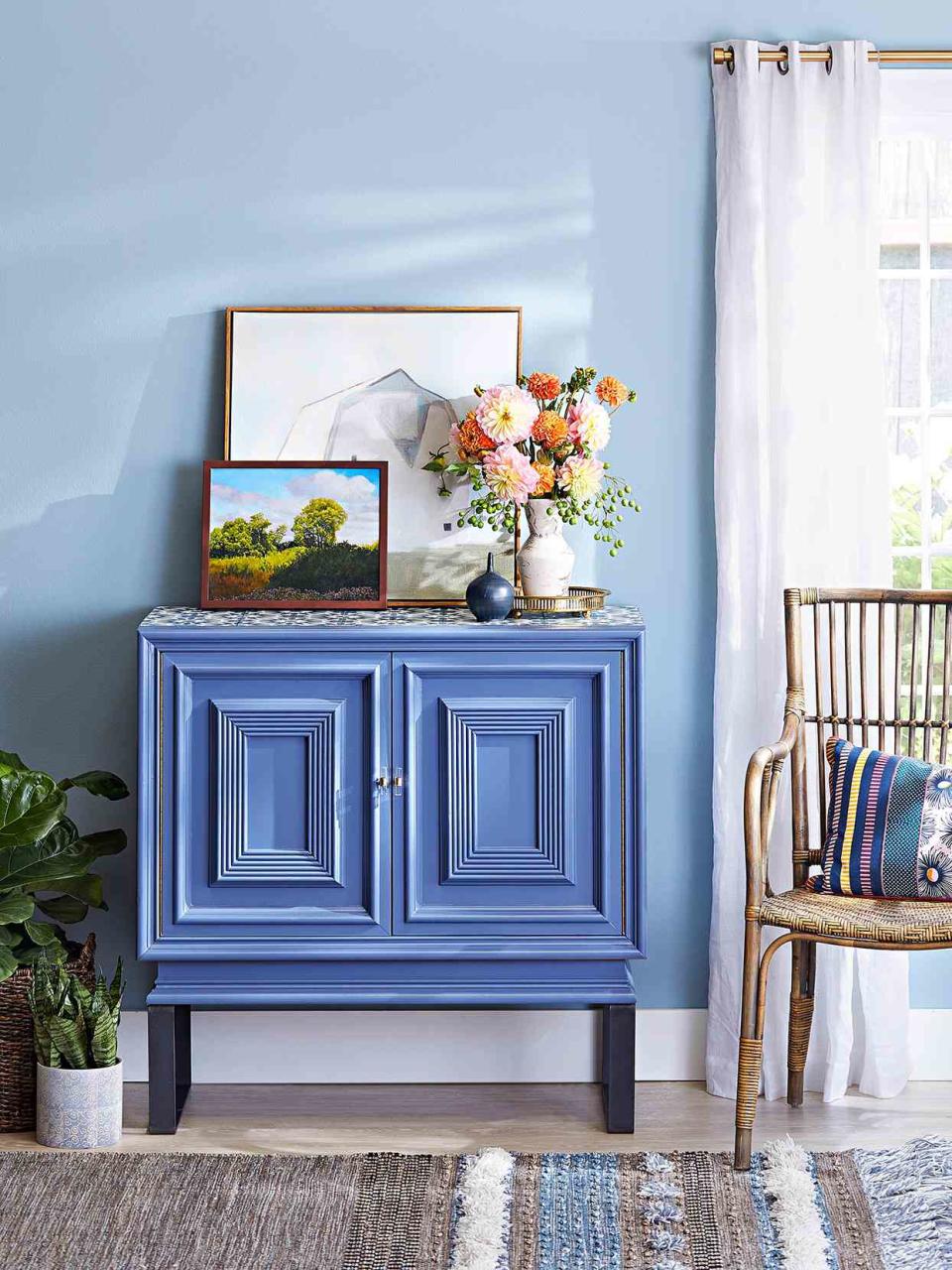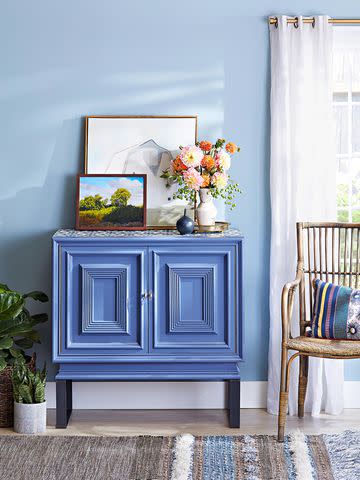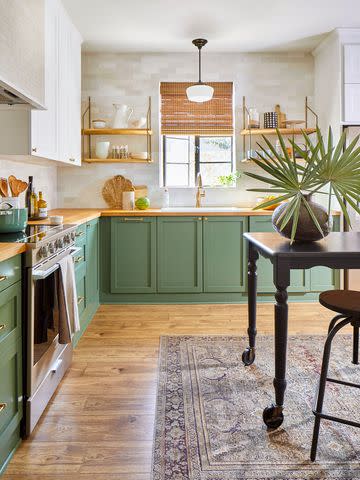What Does It Mean to Color-Match Paint? What to Know Before Trying It
- Oops!Something went wrong.Please try again later.
Paint pros share their best tips and advice for color-matching paint the proper way.

Imagine you find a vintage decor item in the most ravishing shade of red you’ve ever laid eyes on. You want to paint your living room accent wall in the same color, but after collecting dozens of paint swatches, you just can't find the right fit. This is where the art of paint color-matching comes in handy: If there isn't already a paint color that matches the hue you're envisioning, you can actually create your own.
Another potential scenario you might run into is that you fall in love with a paint color from a company that doesn't come in the finish you want. In this case, color matching can help you achieve the look and sheen you're going for.
To learn how to color-match paint the right way, we talked to top paint professionals about what paint color-matching is, why and how it’s done, and some helpful tips to keep in mind. So, reserve this for a future design project as it can save you time, stress, and money during the process.
Related: Types of Paint: A Guide to Paint Finishes and Surfaces

Katie Charlotte
What Is Paint Color-Matching?
While the term sounds fairly self-explanatory, Ashley McCollum, Glidden’s Paint by PPG color expert, gives us a clear definition. “Paint color-matching is the process of finding a paint color that matches or complements an existing color on a wall, a fabric, a piece of furniture, or any other surface," she says. You can match a paint color to your favorite wallpaper, an item of clothing, or even an accent piece.
Essentially, it’s the ability to produce a color that completely—or at least very closely—matches the one you desire. The actual color-matching process is done with technology that’s also used by physics and chemistry professionals, but it's a fairly simple process for the consumer.
Related: The Best Dark Paint Colors of 2023, According to Color Experts
How the Color-Matching Process Works
The easiest way to color-match paint is by comparing color swatches. Hannah Yeo, Benjamin Moore’s color marketing and development manager, recommends that consumers always try the old-fashioned method first: Matching colors by eye.
Essentially, if you bring a sample of your coveted color to a local paint store, you can peruse their swatches and compare shades side by side. Yeo warns that this takes time, but for a true DIYer, it can evoke a sense of fulfillment. If you can't find an exact match on the wall of paint color swatches, you can turn to the professionals to create the hue for you.
Nearly every paint company conducts color matching the same way. The paint pros use a tool called a spectrophotometer that measures the light intensity of a color sample. Whichever light is transmitted, rather than reflected, is converted into a color formula that is then used to make the matching paint color.
The spectrophotometer has been widely used since the 1990s—but before then, professionals relied on trial and error. Thankfully, the process is a lot quicker these days; you can usually expect to get the color formula within a few hours at most paint stores.
Related: 23 Expert Tips for Choosing the Right Paint Colors for You

Why You Should Try Paint Color-Matching
McCollum explains there are a variety of reasons and situations in which color matching could come in handy—some of which you might not have considered before. Here's what she had to say.
Customization: “Homeowners may want a slightly different shade [than what’s available on the market] or a unique color that suits their personal style or design vision,” McCollum says. She points out that if you want a paint color in the same blue hue as your area rug or bedspread, it will likely require a custom match.
Touch-Ups or Repairs: Say you have a piece of furniture or painted wall that has faded or chipped over time. McCollum suggests that if the original color is no longer available, obtaining a match for touch-ups is usually a better alternative to repainting the entire room. This is also helpful if you've purchased a home and don't know what the original paint colors are.
Discontinued Colors: In the same vein, if you love a particular paint but the product has been discontinued or the manufacturer is no longer in business, you’re still in luck, as long as you can find a small sample of the color to take to the paint store.
Saving Money: If you're coveting a color from a brand that’s out of your renovation budget, consider matching it at a competitor’s store for a more affordable price. It’s common practice within the industry, so don’t feel guilty saving where you can.
Product Availability: “In some cases, the specific brand or product you want may not be readily available in your area,” McCollum says. “Color matching allows you to recreate the desired color using more accessible or locally available paints or finishes.”
Personal Preference: You might have a proclivity for a particular paint brand, for one reason or another. If they don’t carry the color you want for your walls, you can always ask them to make it for you.
Related: Types of Paint: A Guide to Paint Finishes and Surfaces
How to Submit Samples for Paint Color-Matching
Now that you understand the purpose and process of paint color-matching, it’s smart to know how to submit your color samples if and when the occasion arises—especially if you're wanting to match something other than another paint swatch. After all, you can't just carry your entire wall or full-size area rug into the paint store.
According to Sue Kim, Valspar's director of color marketing, there are a few clever ways to get around this problem. "Cut a small sample of paint from your wall, such as a hidden piece around trim, and to bring into Lowe’s where they will take a digital color read and make a custom mix that will beautifully replicate your existing paint," she suggests. You can do this with painted furniture too; just take a small sample from the back of the piece, or an inside area (like a drawer or cabinet) where it won't be noticeable. Color matching services are typically free.
Likewise, Ashley Banbury, color marketing manager for HGTV Home by Sherwin-Williams, recommends bringing your physical color inspiration in any form you can. If you're trying to match a color of bedding, take one pillowcase rather than the entire bedspread. Or, cut a small piece of fabric from an inside seam. She also encourages customers to shop around and have the sample color matched at more than one retailer. If you have a budget to stick to, or are very particular about the color, this can be a helpful option. Plus, as Banbury puts it, “color selection is a very personal experience” so you want to ensure that you’re getting it just right.
Related: 16 Clever Painted Furniture Ideas for a DIY Style Boost

Try an Online Color-Matching App
Many paint companies also provide online tools to help you discover similar paint colors. Rather than physically holding your sample up to the wall of paint color swatches at the hardware store, simply snap a photo and let the app provide you with similar color suggestions.
Glidden, Benjamin Moore, Sherwin-Williams, The Home Depot, and many more all have their own color-matching apps. This method is best for finding a color match to non-painted elements, like colors in a throw pillow or area rug. If you're trying to find an exact match for paint touch-ups, it's usually best to take a physical sample to the store.
Related: The 8 Best Paints for Furniture That Will Give Your Home Decor a Quick Refresh
What to Do If the Color Isn't an Exact Match
Paint color-matching is a very helpful tool, but it's not always perfect. This is something I've learned from a very trusted source—my uncle. Thomas Cornetta is president of Elmont Paint & Wallpaper Inc, a third-generation family-owned and operated paint store. While they are an authorized Benjamin Moore retailer, they’re also a small local business and regularly provide paint color-matching to countless customers.
According to Cornetta (him, not me), it’s tough for any paint store or distributor to produce an identical color match every single time. It’s often due to factors of out their control such as the finish or type of paint you need, slight lighting shifts when using the spectrophotometer, and even the tools you or painters use to apply it. A trained professional can come up with a color very close to your sample about 95% of the time, so he says it’s worth going through the process if you really want that shade of paint.
Related: 23 Fundamental Painting Tips to Know Before You Pick Up a Brush
Since color-matched paint is custom-made, you typically can't return if it’s not to your liking. If this happens, Cornetta offers a few suggestions: First, realize that paint takes a little time to settle, so if you don't love it as soon as you get it home from the store, give it a day or two before deciding if it's not the shade you hoped for. If it still seems off, some retailers will offer to try shading it again, either slightly lighter or darker, which just may do the trick.
If you do end up with a can of paint you don't love and don't plan to use, there are a few ways to unload any unwanted cans.
Donate it to a church, school, or your local Habitat for Humanity ReStore.
Some paints, such as latex, can be recycled. PaintCare Inc. is a non-profit organization with more than 2,400 drop-off sites in the U.S., many of which are paint retailers.
You may be able to recoup the money spent by reselling paint for pick up (delivery is too complicated) on Facebook Marketplace or eBay.
Related: How to Dispose of Paint the Right Way
For more Better Homes & Gardens news, make sure to sign up for our newsletter!
Read the original article on Better Homes & Gardens.

